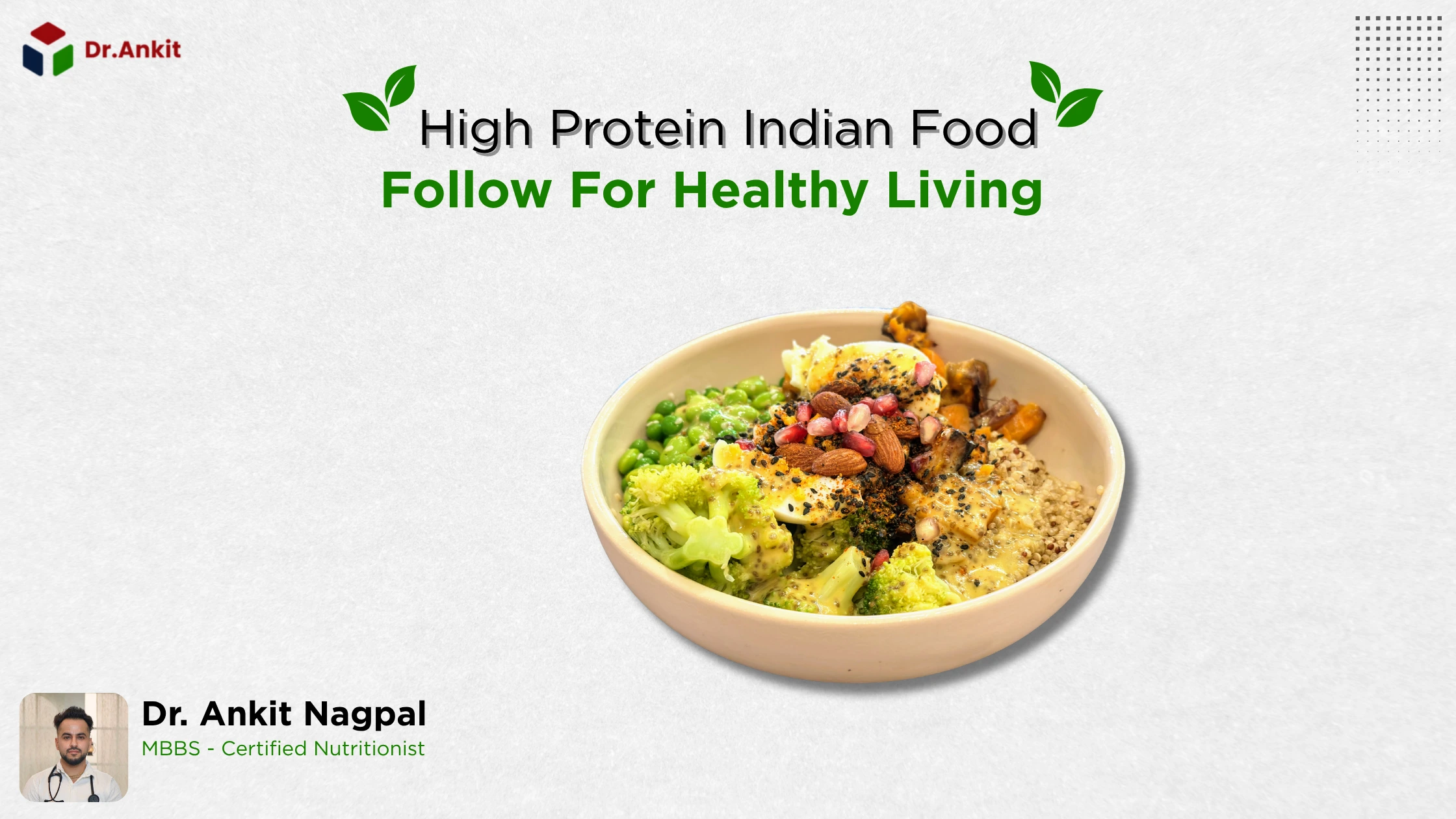Summary
Hello friends, I am Dr. Ankit Nagpal. I’m super excited to chat with you about high protein Indian food today. Regardless of whether you are a vegetarian or you like some cheese, there are numerous protein-rich products in our Indian kitchen that will help you be strong and energized. I will take you through how you can easily incorporate these foods into your meals, I will provide you with a few recipes and some tips that will help make it all work. You will find it so easy to improve your health without having to buy anything after all!
Introduction
I am a doctor and best dietician in Ludhiana who believes that people need to feel their best with food. I have witnessed so many people in my clinic because they are tired or feeble simply because they are not taking in sufficient protein. We Indians are fond of our rice, our rotis, our curries, and we do not remember about this super-important nutrient. The cool thing? Indian food is high protein all over, whether it is the dal cooked by your mom or the paneer tikka at your local dhaba. It is an article you need whether you are looking to lose weight, gain muscle, or just get more energetic. And so as to make our desi meals protein rich and tasty, let us jump in and see how to do it! If you are too looking to a weight loss or weight gain connect with me at Ankit Nutrition Hub.
Why Protein Matters for Us Indians
Protein is like the superhero of nutrients – it builds muscles, keeps your energy up, and even helps your body fight off disease. In India, a lot of us eat loads of carbs (hello, parathas!), but we sometimes skip protien, which can leave us feeling sluggish. I’ve had patients who started eating more high protein Indian vegetarian foods and felt like a new person in just a few weeks. The best part? Our everyday foods like dal and curd can do the trick. Plus, protein keeps you full longer, so you’re not reaching for that extra samosa. Earlier sharing about a protein I shared with my reasons about the curd as good option for protein.
How Much Protein Do You Need?
Here’s the deal: most of us need about 50-70 grams of protein a day, depending on how active you are. If you weigh around 60 kilos, aim for at least 48 grams. If you’re hitting the gym, go for a bit more.
Why Do Indians Miss Out?
A lot of us, especially vegetarians, lean on rice or rotis too much. But what Indian food is high in protein? Think lentils, paneer, or even toffus– they’re game-changers if you add them regularly.
Awesome Veggie Protein Sources
Being vegetarian is a big part of our culture, and guess what? We’ve got some of the best protein rich food for vegetarians right in our kitchens. From creamy paneer to hearty chickpeas, high protein vegetarian foods in India are cheap, tasty, and easy to cook. I’ve seen patients light up when they realize they can get strong without meat. For example, a bowl of rajma or moong dal can give you 15-20 grams of protein, and it tastes amazing with rice or roti. Mix and match these to keep things fun and nutritious.
Lentils and Beans
Dals like moong or masoor are protein powerhouses – about 20 grams per small bowl. Cook them as soup, curry, or even a khichdi for a cozy meal.
Dairy Delights
Paneer’s got 18 grams of protein in a small chunk, and a bowl of curd adds about 10 grams. Toss paneer in a sabzi or blend curd into a lassi for a quick boost.
Low-Calorie Protein Options
Watching your weight? No problem! Low calorie high protein Indian food is perfect for staying full without packing on the kilos. I’ve helped tons of patients with diabetes or weight issues by suggesting these. Sprouts or grilled soya chunks are light but filling, and they’re super easy to prep. Just swap out the oily stuff for roasted or steamed versions, and you’re golden. Trust me, these dishes still taste amazing with our desi spices.
Sprouts and Salads
A cup of moong sprouts has 14 grams of protein and barely 100 calories. Mix with some tomatoes and chaat masala for a quick salad.
Grilled Goodies
Grilled paneer or soya tikka gives you 15-20 grams of protein without the extra calories. Perfect for a light dinner.
High Protein Indian Food Chart
To make life easier, here’s a quick high protein Indian food chart to plan your meals. I always tell my patients to keep a rough track of what they eat – it helps you stay on top of your protein game. For example, did you know 100 grams of chickpeas gives you 19 grams of protein? Charts like these are a lifesaver for busy folks.
Breakfast Boosters
Whip up a moong dal chilla for 15 grams of protein. Pair it with curd for extra flavor. Or try besan cheela for a change.
Lunch and Dinner Ideas
Rajma curry with rice gives you 19 grams from the beans alone. Or go for paneer bhurji with some veggies for a quick meal.
| Food Item | Category | Approx. Protein (per 100g) | Calories (approx.) | Best Meal Use |
| Moong Dal (Green Gram) | Lentils/Vegetarian | 24g | 105 kcal | Dal, Khichdi, Chilla |
| Rajma (Kidney Beans) | Legumes/Vegetarian | 22g | 123 kcal | Curry, Rice Combo |
| Paneer (Cottage Cheese) | Dairy/Vegetarian | 18g | 265 kcal | Bhurji, Tikka, Curry |
| Curd (Plain Yogurt) | Dairy/Vegetarian | 10g | 98 kcal | Lassi, Side Dish |
| Soya Chunks | Plant-Based/Vegetarian | 52g | 336 kcal | Curry, Tikka, Stir Fry |
| Moong Sprouts | Sprouts/Vegetarian | 14g | 100 kcal | Salad, Snack, Tikki |
| Roasted Chana | Legumes/Snack | 18g | 120 kcal | Evening Snack |
| Tofu | Plant-Based/Vegetarian | 8g | 76 kcal | Stir Fry, Curry, Salad |
| Almonds (Handful/28g) | Nuts/Vegetarian | 6g | 160 kcal | Snack, Topping, Smoothies |
| Quinoa (Cooked) | Grain/Vegetarian | 4g | 120 kcal | Salad, Bowl, Pulao |
| Besan (Gram Flour) | Legume Flour/Vegetarian | 22g | 387 kcal | Chilla, Pakora, Roti |
Why a High Protein Diet Rocks
Eating more protein can seriously level up your health. It revives your metabolism, helps you manage weight, and keeps you feeling strong. I’ve seen patients on an Indian vegetarian protein diet say they’re less hungry and have more energy for work or play. High protein vegetarian foods are all over India, so it’s easy to make this work. Just stick with it, and you’ll notice the difference.
Weight Control
Protein makes you feel full, so you’re less likely to munch on junk. Lean protein sources veg like tofu are great for staying fit.
Muscle Power
Protein helps your muscles grow and recover. Check out the top 10 sources of veggie protein, like nuts or quinoa, for vegetarians.
Adding Protein to Your Everyday Meals
Making high protein Indian food part of your routine is easier than you think. It’s not about strict diets but small, tasty changes. Start with a protein-heavy breakfast to kick things off right. I always tell my patients to mix things up so you don’t get bored. High protein vegetarian foods like soya chunks can even feel like meat if you’re trying to cut back.
Snack Smart
Grab a handful of roasted chana or almonds – about 15 grams of protein in a quick bite.
Meal Prep Hacks
Cook a big batch of dal or paneer curry on Sunday to use all week. Saves time and keeps you on track.
Tackling Common Problems
Some folks worry about gas from beans – just soak them overnight, and you’re good. Or if you’re on a budget, stick to local stuff like chana or moong. High protein Indian food doesn’t have to break the bank.
Easy Digestion
Add a pinch of hing or ginger to your dals to help your tummy handle them better.
Budget Tips
Buy seasonal pulses or local paneer instead of pricey imports like quinoa.
FAQs
A: Lentils, chickpeas, paneer, soya chunks, tofu, curd, sprouts, nuts, seeds, and quinoa are your go-tos.
A: Aim for 20 grams of protein per meal with dals, paneer, or tofu if you eat them.
A: Sprouts salad, grilled paneer, or moong dal soup – all under 200 calories with solid protein.
Yes, they are safe when taken in the right amount under the guidance of a qualified nutritionist or dietician. They act as a healthy support to your diet.
They provide quick nutrition your body needs – helping in muscle repair, strength, energy, and filling dietary gaps when regular food isn’t enough.


